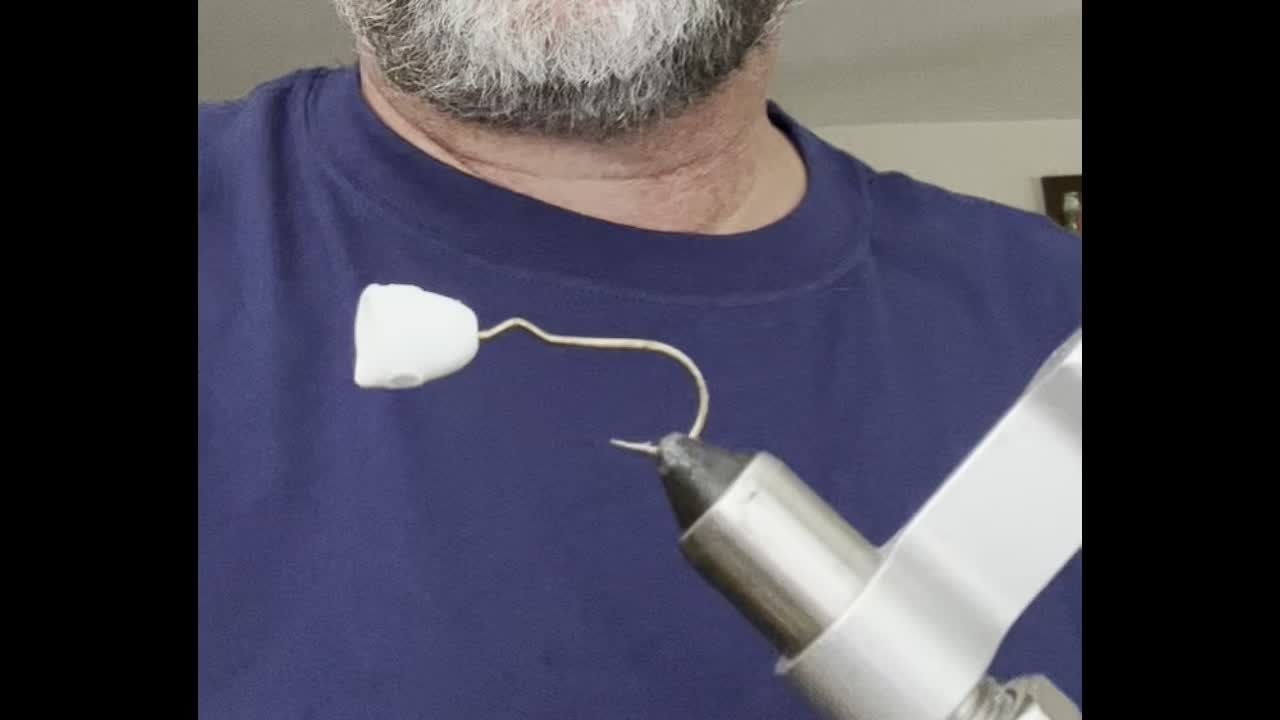Premium Only Content

Froggy Popper on #6 hook fly tying
When it comes to topwater flies for panfish, anything goes. That is one of the things I love about warm water fly fishing. Panfish, bass, and other warmwater predators like pickerel and pike are not concerned that your offering is not an exact replication of the last thing they ate. If it looks alive and can fit in their mouth, they will often have a go at it.
The lack of demand for realism in fly patterns is one thing that sets warmwater fly fishing apart from trout fishing. We are far more concerned with matching the hatch and delivering a proper presentation in the trout world. Warm water fly fishing is a more rough and tumble affair. Fly selection based on whim and fancy can be just as effective as attempting to match what the fish are currently eating.
Looking into one of my warmwater fly boxes, you see a lot of whim and fancy. Garish colors like chartreuse, fluorescent yellow, bright pink don't often occur in the natural world. Based on the contents of my fly boxes, you would think that panfish live in a world filled with psychedelic colors. There is no doubt that these brightly colored, un-natural looking flies work. If they didn't, they would not take up so much room in my fly boxes. However, if you look close enough, you will find more natural-looking flies mixed in with that kaleidoscope of colors.
Maybe the decades spent chasing trout keep me coming back to more natural-looking flies that imitate the things that panfish eat. I enjoy tying and fishing patterns like damselflies and dragonflies, two essential food items for warm water fish. Also mixed in with the odd-looking foam and hair creations, you will find a smattering of flies that you can readily recognize as terrestrial insects like hoppers, beetles, and ants. The natural-looking flies that stand out the most are the frogs. My frog patterns are instantly recognizable as the amphibians that are meant to represent.
Everyone knows a bass or a pickerel has a hard time ignoring a properly presented frog pattern, but panfish? You can make the argument that most adult frogs are too big of a prey item to be eaten by most panfish. However, there are smaller species of frogs whose habitats mix with that of panfish. In my area, the Northern Cricket Frog is one such example. While technically a tree frog, it does not take to the branches but prefers a more aquatic existence. They are often found along the muddy banks of ponds and slow-moving streams. As an adult, they range in size from three-quarters of an inch to an inch and a half, which firmly puts them in the size range of something big bluegill would try to eat.
If you search the pages of this blog, you will find several small frog patterns that I tie and fish exclusively for panfish. Most are created using a foam or preformed body. The fly pattern in today's post has been teased in a few recent posts and on social media. Each time I show a picture of it, I receive messages and emails requesting more information on the pattern, so I figure it is high time I share it with the world.
This pattern is tied using flat foam. I have tied small frog patterns using flat foam in the past but have never been entirely satisfied with them. Thin 2mm foam does not have the bulk needed to imitate a chunky little frog, and the thicker foam I have worked with in the past was tough to work with on the small scale in which these flies are tied.
After joining Semperfli's team of fly tiers, I was introduced to a new type of foam. Semperfli's flat foam is a closed-cell foam, but the air pockets or cells are larger than what is found in most fly tyers foam. This characteristic means the foam compresses easily. Their foam is also remarkably strong and resists tearing quite well. Because it compresses so well, I can use thicker foam, in this case 4.5mm, to create a frog body on hooks as small as a size 12. Combine a body made from this thick foam and Pat Cohen's Creature Frog Legs; you have the perfect panfish-sized frog pattern.
You could tie the fly very simply with just those two materials, but I like to add an underbody that adds a little sparkle and movement by using a material like Semperfli Straggle String or Straggle Legs. It gives the fly a finished appearance along with added color, movement, and flash. Rubber legs are a must because a topwater bluegill fly without rubber legs doesn't feel right.
I have been anxiously awaiting the arrival of warmer weather and the return of my favorite pastime, topwater fishing for panfish. There is something about bluegill taking a fly off the surface that puts a smile on my face every time. Finally, it appears my wait is over, and mother nature has warmed things up to the point that my favorite fish have returned to the shallows and a looking up for their next meal.
One of the things I love about fishing tiny frog patterns for panfish is the take. Bluegills often slide under a topwater fly and suck it off the surface with an audible slurp. Not the case with a frog pattern. They seem to know that this type of prey can elude them if they're not careful, and they grab them off the surface with a vengeance, more like the take of a bass. I am often surprised when a big bluegill comes to hand, mistaking the violent take for a bass.
-
 1:55:34
1:55:34
Steven Crowder
6 hours agoLA Riots: Trump Tries to Save LA & Gavin Newsom Wants it to Burn
446K413 -
 1:07:39
1:07:39
The White House
2 hours agoPresident Trump Participates in Invest America Roundtable
15.1K23 -
 LIVE
LIVE
The HotSeat
1 hour agoNot Here for the WHAT — I’m Here for the WHY LA Is Burning
721 watching -
 LIVE
LIVE
Akademiks
6 hours agoBREAKING NEWS!!! 50 CENT RESPONDS TO HIS BM ON THE STAND AT DIDDY TRIAL. Day 18 of Diddy Trial. 5/30
1,950 watching -
 20:17
20:17
Stephen Gardner
1 hour ago🚨Trump SCORES MASSIVE win despite RADICAL LEFT judges!
1.21K20 -
 LIVE
LIVE
Film Threat
17 hours agoVERSUS: JOHN WICK: BALLERINA + SUPERMAN NEWS! | Film Threat Versus
92 watching -
![[Ep 684] Mostly Peaceful Protest | Dems & Their Love of Lawlessness | Greta’s “Selfie Yacht” Fail](https://1a-1791.com/video/fww1/6c/s8/1/5/x/O/R/5xORy.0kob-small-Ep-684-Mostly-Peaceful-Prot.jpg) LIVE
LIVE
The Nunn Report - w/ Dan Nunn
1 hour ago[Ep 684] Mostly Peaceful Protest | Dems & Their Love of Lawlessness | Greta’s “Selfie Yacht” Fail
165 watching -
 2:00:41
2:00:41
Russell Brand
4 hours agoLA BURNS! Trump Sends In National Guard Amid CIVIL WAR Threat - SF593
141K55 -
 LIVE
LIVE
StoneMountain64
3 hours agoNew CoD Revealed + WTF is Splitgate 2 Doing
189 watching -
 1:00:27
1:00:27
Sean Unpaved
3 hours agoGaines' Battle for Title IX, Pittsburgh's Playoff Push, & Why Chubb Matters in Houston
29.6K1